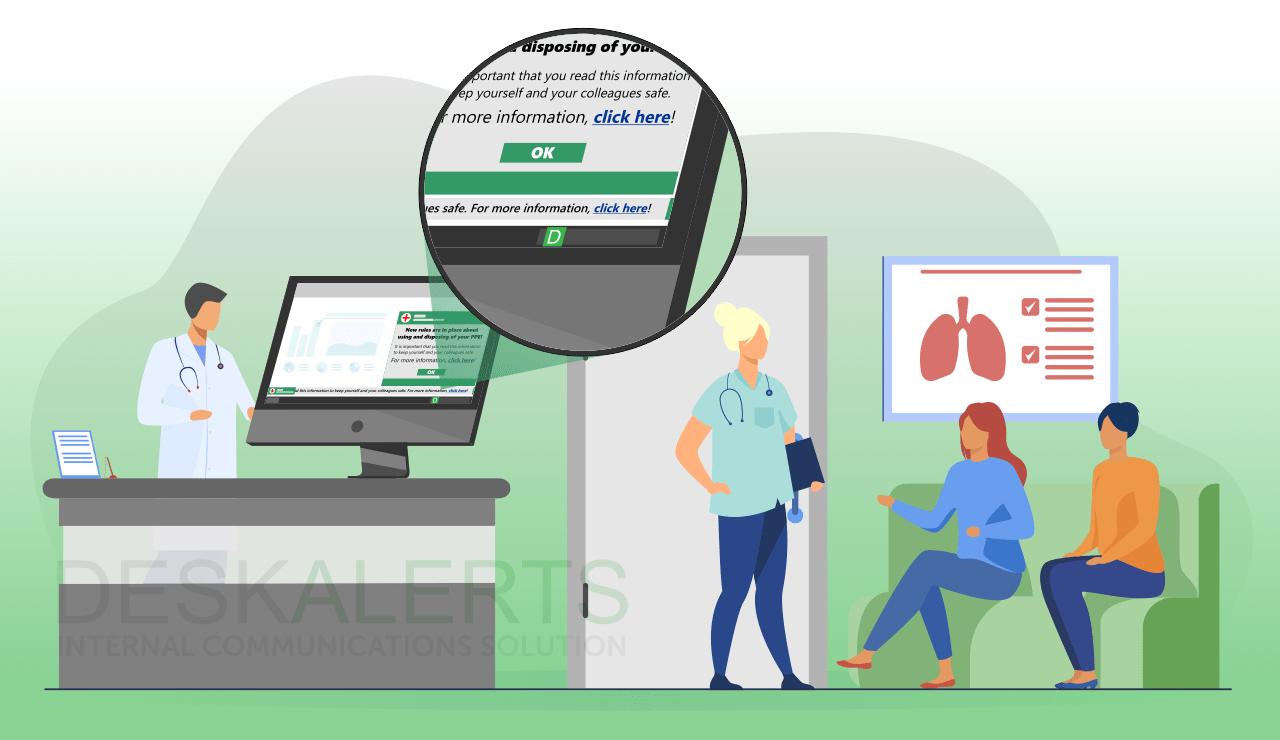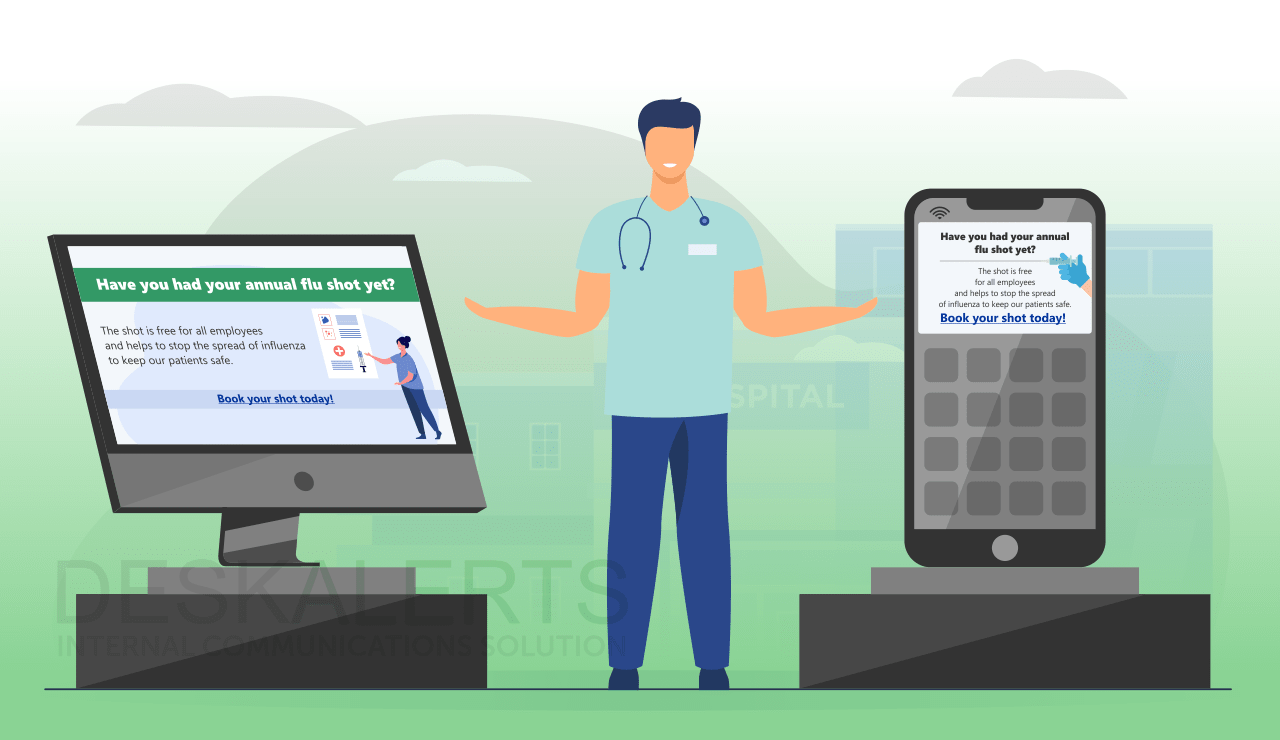
Internal communication in healthcare is important for positive patient outcomes and to ensure that healthcare organizations run smoothly and efficiently. However, internal communications in the healthcare industry can be extremely challenging compared to other industries.
The diverse nature of the healthcare workforce and the unique structures of healthcare organizations mean that strategies for communicating with employees that work well elsewhere might not always work in this sector.
Table of contents
The importance of communication in healthcare settings
Challenges for internal communication in healthcare
Tools to improve internal communications in healthcare organizations
Tips for communicating effectively in healthcare
The importance of communication in healthcare settings
Effective communication is essential for both informing and engaging your employees. There are many important reasons why the healthcare organization should make it a priority:
- Employees need to keep pace with various federal and state regulations that apply to healthcare.
- Employees need to stay up-to-date with key developments in healthcare, disease outbreaks (such as COVID-19), policy and procedural changes, and new initiatives.
- Lack of effective communication can result in rumors or misinformation circulating, damaging employee morale and external reputation with stakeholders if disgruntled staff members spread rumors outside the organization.
- When communication is poor, people can make mistakes. In healthcare, this can be the difference between life and death for patients – the importance of communication in hospitals doesn’t get more serious than this.
- Employees will have a clear understanding of what is expected of them.
- You can help to ensure employees understand the organization’s vision, goals, and mission.
- Ensuring that organizational change initiatives are successful.
- Driving up levels of employee engagement. The healthcare sector has one of the lowest employee engagement levels compared with other sectors.
Towers Watson research found that less than half (44%) of hospital employees in the USA are highly engaged.
- Making sure employees know about new training opportunities.
- Being able to reach employees in an emergency so that you can respond appropriately and efficiently.
- Improvements in efficiency and productivity and reduced operating costs.
- Improvements in collaboration and teamwork.
- Prioritizing communication as part of a patient-centric approach enhances understanding, engagement, and overall quality of care.It fosters trust, ensures clarity in treatment plans, and encourages patient involvement.
- Improved internal communication among healthcare staff enhances coordination, reduces errors, and promotes a culture of collaboration. This synergy translates to better patient outcomes, reduced medical errors, and higher-quality healthcare delivery overall.
Challenges for internal communication in healthcare
The importance of effective communication in healthcare settings cannot be understated. But all too often, it is carried out poorly because barriers to good communication can seem difficult to overcome, or inefficient hospital communication systems, processes, tools and technologies are in use within healthcare organizations.
Challenges include:
- Complexities in reaching staff who work in various roles, at different hours day and night, and sometimes spread out in several locations.
- Reaching employees at all given the chaotic nature of healthcare and all the distractions they have.
- Reaching staff who do not work in a traditional office environment with their own desks and computers.
- Outdated communications systems still in use, such as pagers and fax machines.
- Having some members of staff who were traditionally on-site now working remotely due to COVID-19.
- Ongoing issues with lack of employee awareness around cybersecurity.
According to the Emisoft State of Ransomware report, in 2020 alone, more than 560 healthcare providers were victims of ransomware which can cripple systems and put patient safety at risk.
>> Learn how to protect your organization from ransomware <<
- Keeping employees informed throughout the pandemic as situations can change rapidly as outbreaks escalate.
- Having to distill often complex information to ensure that it is understood and will be acted on.
- Conveying the urgency of care and emphasizing the importance of avoiding delays to other staff members so they are aware of patients’ conditions and the critical need for immediate action.
Tools to improve internal communications in healthcare organizations
With these challenges in mind, it is clear that a one-size-fits-all approach to communicating in the healthcare industry will not be appropriate or effective.
While some organizations don’t communicate regularly with employees (or communicate with them at all!) others take approaches to employee communications that haven’t been updated for decades. This is a case of management not correctly understanding the importance of communication in healthcare.
Using various internal communications channels will help get your messages out there, even if it feels like you are repeating yourself. Like any successful marketing campaign, repetition can be the key to individuals retaining information and should be a cornerstone of your communication strategy in healthcare. This can include a blend of traditional methods of communication in healthcare as well as boosting your message reach with innovative digital tools and communication systems in hospitals.
Traditional internal communication methods in healthcare include:
- Emails: Many organizations rely on sending all-staff emails, hoping that everyone is kept informed. However, people tend to get email fatigue, so these should be used strategically and sparingly. There is also the issue that not everyone has access to emails or can regularly look at them due to the nature of their work.
- Employee newsletters: Regular employee newsletters are a good way to send lots of information electronically without overwhelming staff with too many emails.
- Team meetings: Quite often, employees prefer to hear important information directly from their managers. Regular team meetings are a good way to keep everyone in the loop.
- Intranet: The intranet is a good resource to post important information that everyone needs to know about. However, in many organizations, the intranet is overloaded with information that people cannot easily find,
- Noticeboards: This old-fashioned method is tried and true. Bulletin boards in staff kitchens and meal areas, common rooms and so on are still likely to get the attention of employees who don’t work from a traditional desk.

Digital tools to enhance your internal communications include:
- Blogs: Use your intranet system to create blog posts where staff can share information.
- Video: Creating videos that staff can watch at any time of the day or night can help to bridge the divide that comes with shift-work, which is often an issue for communication in the hospital.
- Pop-up alerts: Send messages to desktops with important information, bypassing the need for an employee to be looking at their inbox when the information is time-sensitive. In healthcare, this is particularly useful for shared computers, such as in hospital wards.
- Desktop tickers: A scrolling band of text along the bottom of computer screens can ensure that information that isn’t time-sensitive appears in front of employees with computer access.
- Digital signage: as part of a communication system in hospital: Transform screens inside your organization into digital billboards and create colorful and engaging information campaigns targeted at your employees.
- Employee apps: With the proliferation of smartphones and other devices such as tablets, it’s never been easier to reach employees no matter where they are located or what time they are at work. Employee apps as part of your healthcare communication system can send notifications to phones, ensuring that everyone knows what is going on.
- Corporate wallpaper, screensavers and lock screens: Capitalize on your own computer systems and use otherwise blank, unused space on employees’ screens to inform them about corporate initiatives.
- Instant surveys, polls and quizzes: Two-way communication is important to enable employees to inform management about what is happening on the ground. When you have a diverse workforce, it can be challenging to obtain feedback quickly. With digital surveys, polls and quizzes you can reach them instantly and get the results in real time.
- Interactive training modules: Specially designed employee training modules can be taken at a time that suits the employee and is delivered in a uniform way, eliminating the need to gather everyone in a training room simultaneously, which can be a logistical challenge with scheduling.
- Instant messengers: Employees can save time and spare inboxes by sending instant messages to colleagues when they need quick clarification on something or brainstorming ideas when they can’t be face-to-face. It’s faster than playing email ping pong.
Tips for communicating effectively in healthcare
Once you’ve determined the right mix of tools to use to communicate within your healthcare setting, consider these tips on how to improve communication in healthcare:
- Ensure you have management support – good internal communication relies on the leaders in your organization to commit to it.
- Effective internal communications strategies in hospitals should ensure there is no addition of unnecessary “noise” to employees and should deliver important information in a timely and succinct manner
- Employees shouldn’t be overwhelmed and overloaded with information. For example, if you need physicians to know about new protocols, don’t send the information to every single person who works for the hospital.
- Remember that the information being passed on internally is both critical and time-sensitive, so the channels of communication you choose to distribute your message must be efficient and also kept unclogged.
- Consider the importance of communication between healthcare professionals. Just as it is important that doctors communicate clearly with their patients to ensure that follow-up care at home is understood, it’s also important that staff communicates with one another in a clear way, avoid ambiguity, and ensure the best outcomes for patients.
- If you have important but not time-sensitive information, you can schedule it in advance to be sent to employees later.
- Ensure that internal communication includes all topics of interest or relevance to your employees. As well as broader health information, policies and procedures that affect them, you should also ensure they are kept up-to-date with cybersecurity tips, IT outages, payroll information, workplace safety and wellbeing information, news about major projects and changes etc.
- Make sure your communications are clear and concise and written in accessible language.
***
Recognizing the importance of communication between healthcare professionals and the hospital and healthcare setting is the first step. Taking the proactive next steps to commit to and deliver effective improvements will benefit the organization, your employees, and your patients.
FAQ:
Why are communications important in healthcare?
Effective communication in healthcare is crucial for several reasons. Firstly, clear communication between healthcare providers and patients ensures that medical information is accurately conveyed, leading to better diagnosis and treatment outcomes. Additionally, strong communication fosters trust and empathy, enhancing the patient-provider relationship. It also facilitates collaboration among healthcare teams, promoting coordinated care and preventing errors. Ultimately, good communication systems in healthcare promote patient satisfaction, improve health literacy, and contribute to overall better healthcare delivery.
Why is organizational communication important in healthcare?
Organizational communication is vital in healthcare for various reasons:
- Facilitates smooth operations and coordination among staff.
- Ensures consistent dissemination of policies, protocols, and guidelines.
- Promotes a culture of transparency and accountability.
- Enhances teamwork and collaboration, leading to better patient care.
- Enables timely response to emergencies and changes.
- Improves overall efficiency and effectiveness of healthcare delivery.
What is the internal communication plan of a hospital?
The internal communication plan of a hospital typically includes:
- Regular staff meetings to discuss updates and concerns.
- Use of internal messaging platforms for quick communication.
- Distribution of newsletters or emails to share important information.
- Training sessions to ensure staff understand protocols and procedures.
- Feedback mechanisms to address issues and improve communication channels.
Why is communication important in healthcare nursing?
Communication is crucial in healthcare nursing. It ensures accurate transmission of critical patient information among healthcare teams, aiding in proper diagnosis and treatment. Effective communication builds trust and rapport with patients, enhancing their understanding of their conditions and treatment plans. It also fosters collaboration among nurses and other healthcare professionals, leading to better patient outcomes and overall quality of care.



